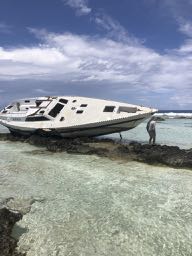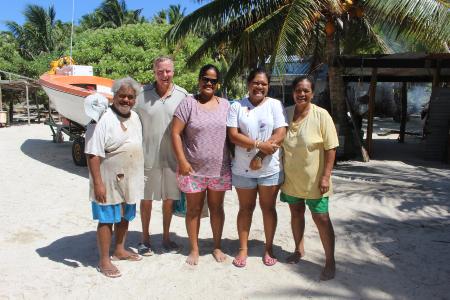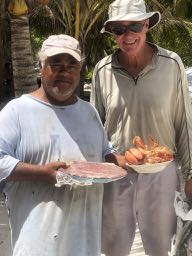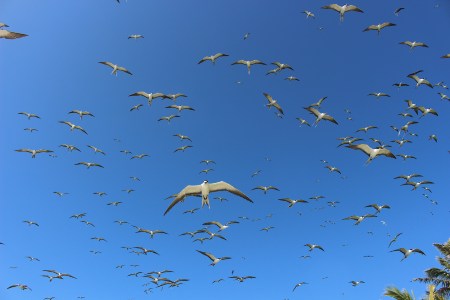French Polynesia, Society Islands: Cruising notes for Maupihaa Atoll
Maupihaa Atoll, also known as Mopelia, is situated on the western edge of the Isles Sous Le Vent (Leeward Isles) of the Society Islands, west of Raiatea. SY Rumpus visited here in November 2019 and have provided some useful notes for yachts planning a visit to this small, friendly atoll.
Published 6 years ago
Maupihaa Atoll is approx. 8 km in length with a lagoon that has depths of up to 40m. It is surrounded by submerged reefs on three sides with just a small passage on the western side of the atoll. The eastern side consists of a narrow island covered in thick vegetation (Motu Maupihaa) as well as some smaller islets which provide a land area of 2.6 km². Motu Maupihaa houses the only village on the atoll with a population of 18 people.


From S/Y Rumpus, NZ 1334
Maupihaa Atoll has a narrow pass with a strong outgoing current. On approaching from the NE you can see a wreck on the reef; a monohull that came to grief in July 2019.
THE PASS:
Co-ordinates: 16 degrees 46.65 minutes S, 153 degrees 58.90 minutes W (pass entry outside the eddies and disturbed flow). These coordinates are from Charlie’s Charts 7th edition.
Time your arrival for the morning; approximately 08:00. The current is at a weaker ebb then although it still is about 5-6 knots outgoing and eddies and swirls outside the entrance. The pass is approximately 18 metres wide. Entering the pass, you are facing east.


- Exiting the pass with 6 knots of current behind us. It is a lot easier exiting than entering through the eddies and overfalls with the current against you. You can see the small white balises marking the inner margins of the pass on each side.
Visibility is tricky because of the glare from the low morning sun. It is imperative to have someone on lookout at the bow. There are undercut shelving banks of coral on each side.
The channel is minimally marked with two slender white and black poles. Once through the narrow outer pass, there are two options: although the channel to the left is deeper, the locals recommend the channel to the right which is marked with clusters of orange buoys on each side.
If you’ve been lucky and caught fish during your passage be aware that the blacktip reef sharks will be very interested. They do not bite humans but they are attracted to the vibrations and smells of boats.
Exiting the pass, again morning is recommended. You then have a beat back to Maupiti or Bora Bora overnight or can continue on westwards to other countries.
ANCHORING:
Anchoring is essential, there are no mooring buoys, and it is tricky as there are many large coral heads in the lagoon. Ensure you have good overhead sun when you anchor. We draw 2.65 metres, so took some time to find the right spot, anticipating where a wind change might take us. The SE corner of the atoll is recommended but if the wind goes North it’s better to go to the NE corner, where you can anchor off from the Raiohos’ house. The colour of the water clearly delineates the depth.


- The Raioho Family
THE LOCALS:
Approximately 18 people live there, scattered along the 8km long main island. They are welcoming to yachts and appreciate gifts of useful things, from tobacco and jam to LED bulbs and boat parts.
We recommend you take some items ashore when you first visit. It really helps if you speak some French. If you’re lucky the locals may reciprocate by inviting you to share a meal: lobster, tuna sashimi, or coconut crab (Kaveū) – which is very rare in the Pacific these days and a real delicacy.


THE WILDLIFE:
Motu Aveu and Motu Tavae are the dominions of the birds. The local humans leave them alone. Thousands upon thousands of terns (Tara iti) flock there to breed. You can visit but they will raise a fuss. Their speckled eggs are laid in shallow hollows in the sand so they are very vulnerable. The hatchlings are very well camouflaged, so avoid the bushes and low trees where they shelter.


Kristin and Rupert
SY Rumpus
http://www.rumpus.co.nz/
Other Reports from SY Rumpus:
…………………………………………………………………………………………………………………………………..
The opinions expressed in this article are the author’s own and do not reflect the view of Noonsite.com or World Cruising Club.
Related to following destinations: French Polynesia, Society Islands






